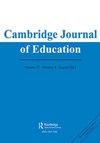Managing cognitive dissonance in art teacher education
IF 1.5
3区 教育学
Q2 EDUCATION & EDUCATIONAL RESEARCH
引用次数: 1
Abstract
ABSTRACT This paper presents autoethnographic strategies to manage cognitive dissonance in art teacher education. Dissonance, as a conflict in beliefs and actions, is discussed in educational research but not commonly in art education. By exposing the autoethnographic voices of three academic artist teachers based in the United Kingdom and Singapore, including that of one author, this paper identifies the constitution and location of cognitive dissonance in art education. Autoethnographic images and excerpts help reveal personal accounts of cognition whilst positioning dissonance in practice. Contributors to dissonance like belief and concept conflicts, demonstrative challenges and power relationships are also exposed. This paper recommends that educational stakeholders, such as education ministries, teacher education departments and school leadership teams collaborate to acknowledge, accept and begin to manage dissonance in art teacher education.管理美术教师教育中的认知失调
本文提出了在美术教师教育中处理认知失调的民族志策略。不和谐,作为一种信仰和行为上的冲突,在教育研究中有讨论,但在艺术教育中并不常见。本文通过对英国和新加坡三位学术艺术家教师(包括一位作者)的民族志声音的揭示,确定了艺术教育中认知失调的构成和位置。民族志图像和摘录有助于揭示个人对认知的描述,同时在实践中定位不和谐。导致不和谐的因素,如信仰和概念冲突、示范挑战和权力关系也被暴露出来。本文建议教育利益相关者,如教育部、教师教育部门和学校领导团队合作,承认、接受并开始管理艺术教师教育中的不和谐。
本文章由计算机程序翻译,如有差异,请以英文原文为准。
求助全文
约1分钟内获得全文
求助全文
来源期刊

Cambridge Journal of Education
EDUCATION & EDUCATIONAL RESEARCH-
CiteScore
5.30
自引率
4.30%
发文量
35
期刊介绍:
Cambridge Journal of Education publishes original refereed articles on all aspects of education, with a particular emphasis on work that contributes to a shared understanding amongst academic researchers, theorists, practising teachers, policy-makers and educational administrators. The journal also welcomes the submission of systematic review articles that summarise and offer new insights into specific areas of educational concern. With a wide international readership, Cambridge Journal of Education publishes contributions drawn from different educational systems and cultures enabling continued in-depth discussion of global educational theory, policy and practice. The journal’s Special Issue programme encourages and stimulates focused discussion and engagement with significant themes and responses to topics raised by readers and contributors. Cambridge Journal of Education welcomes proposals for future editions.
 求助内容:
求助内容: 应助结果提醒方式:
应助结果提醒方式:


